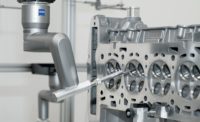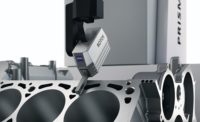There’s a place in the world for high-priced, top-of-the line systems, and there are applications for which nothing else will do. But in today’s competitive markets there’s a lot to be said for getting the functionality you need without spending more than you have to. When it comes to choosing systems for critical measurement applications cost is always an issue, as it should be. But there are others as well; after all, there’s no right price for the wrong system. The key is to find a balance, the best price for the system that meets your needs. In performing that calculation, it is critical to remember that the price tag is only one factor. There are considerations that can have significant financial consequences, directly affecting your total cost of ownership and operation.
TECH TIPSBuying a new system begins with identifying your present priorities and, as far as possible, anticipating future requirements. Identify the capabilities needed to meet those needs. Add in costs of labor, possible downtime, air, and other incidentals. Before you make a purchase, compare your options, preferably not on paper but in hands-on demos. |
Job #1: Accuracy
Obviously accuracy will be a key consideration, though the necessary degree of accuracy can vary with your application. A system’s capabilities should match both your current needs and those you may have in the future, but accuracy is not a uni-dimensional metric like horsepower. A system’s accuracy depends on how you use it: the sensors that are needed to measure the workpiece, the shape of a workpiece, the angle at which the system has to approach it, the required length of a probe working in deep holes, and more.
A lot of factors contribute to a system’s accuracy. Its design and construction have significant impact. Resistance to temperature fluctuation, affected by design, material choices, and insulation, ensures that your measurements will be both accurate and consistent and can reduce or eliminate the need for mathematical compensation. It can also allow you to install the system on the shop floor rather than in a costly, often remote or environmentally-controlled lab.
Similarly, the rigidity of system components helps ensure that you are measuring the workpiece rather than flex in the measuring system. Rigidity in fixed components is relatively simple, but gets more challenging in moving elements. The inertia of unnecessarily heavy moving parts can slow down operations.
Finally, consider the measurement technologies available. There are applications in which the most accurate tactile measurements, for example, won’t be as effective as optical or laser measurement, or vice versa. If the measurement you’ll be doing is specific, limited, and unlikely to change, then a single-function machine may be all you need. On the other hand, if your needs vary (or may change in the future) the ability to support multiple technologies will be critical.
Flexibility: the Right Machine for the Job(s)
Multi-functionality can be beneficial, but can also entail unacceptable compromise. For example, shortly after WWII, an enterprising company introduced a vehicle that could be driven to, and then into and around a body of water. It was the world’s very best car-boat; but it wasn’t a very good car, and it wasn’t a very good boat. Flexible systems can be useful and cost-effective, but you have to be sure you are getting the range and level of functionality you need.
Consider the maximum measuring volume the machine can accommodate. A too-small system obviously won’t handle your bigger parts, but a too-large system takes up space and capital that could be put to better use. Look for a line that lets you “right-size” without sacrificing capabilities you need.
Consider measuring methods. Tactile and optical techniques each have their place, and if one machine can do both (and do both well) you’ll get more effective measurement across the board without having to buy two machines.
Of course you’ll want to accommodate a range of tactile sensors. The wider the range a system can handle, the more flexibility it will provide. Considerations include size of sensors and the angles at which they can operate. You may want to consider scanning heads offering electronic rather than spring buffering for maximum speed and accuracy.
Active scanning technology allows unknown contours to be scanned; this can be particularly useful for tasks like reverse engineering of parts.
A sufficiently flexible system will require fewer stylus changes. And when you do change styli, a system with quick-change capability will simplify the operation and save time.
For optical sensors, consider the granularity of measurement—smaller is better—and look for a choice of measuring ranges to maximize accuracy when measuring parts of different sizes.
If you think you may need laser scanning for extremely fast measurements of freeform workpieces, look for a system that offers that option.
When considering add-on components to increase system capabilities, keep in mind that they must work together to be effective. While components from different manufacturers can be integrated into a single system, the more manufacturers involved, the more complicated that process can be. This applies both to initial integration and to ongoing operation and support.
Speed: Time Really is Money
In some cases, increased accuracy can be “purchased” by slowing down measuring operations and reducing throughput. That may be acceptable if you have plenty of time, but when throughput is important, you can’t afford to sacrifice speed to achieve accuracy. Of course any scanning system will be faster and more accurate than the “spot checks” of a touch-and-go system. But not all scanning systems are alike.
The technologies used by scanning systems vary and can have a huge impact on their speed. Using the right stylus for the application helps ensure accurate results, and when a stylus change is required, quick-change capability keeps things moving. Once scanning has started, a system’s ability to “fly over” gaps in a contour can shorten programming time and speed up measurements. This can speed up measurements when scanning over boreholes, scanning teeth of a gear wheel, or scanning an interrupted plane. Depending on the measurements being done, these capabilities can significantly shorten per-part run times and in a busy shop can reduce the number of machines needed to handle the workload. As with many “high end” capabilities, this feature was initially available only on the most expensive systems but is now working its way down to more economical systems.
Efficiency and Ease of Use
Metrology systems are getting smarter all the time, but they are still run by people. The machine’s intelligence, in the form of software, has a significant impact on ease of use and level of experience required of the operator. An intuitive system with a touch screen and user-friendly display requires less training and less expertise of your operators. It can also reduce setup time for experienced and less-experienced users alike.
Characteristic-based software allows programmers and operators to easily maneuver through measurement plans. User-oriented features like the ability to visually superimpose actual measurements over design specifications help eliminate both out-of-spec parts and unnecessary scrapping of acceptable parts. And if you use a variety of machines, the ability to use the same software across multiple systems eliminates complexity and cuts training costs.
Efficiency can also be found in some unexpected places. Many systems use compressed air to reduce friction, and while air may be free all around us, the stuff in tanks costs money. An option that reduces compressed air use can quickly pay for itself. And ready availability of factory-trained service can help ensure that problems are addressed quickly and effectively to keep equipment operating and correct faults as quickly as possible.
It All Adds Up
While the price of a system may be the only fully definable cost at the time of purchase, other considerations mentioned below have financial ramifications.
Accuracy
Accurate identification of conforming and out-of-spec parts maintains quality, protects the integrity of the entire production process, and reduces scrap rates.
Protection from temperature fluctuation and shop floor conditions allows inline installation, reducing the cost and delay of transporting parts for testing and allowing faster identification and correction of production problems.
Flexibility
Right-sizing of machines eliminates the cost of capacity you don’t need.
The ability to perform tactile, optical, and laser measurements with the same base system can eliminate the cost of multiple machines.
The ability to scan unknown contours eliminates the cost of sending parts out for reverse engineering.
Reduced need for stylus changes or a quick-change capability, and increases throughput.
Speed
Maximized throughput can reduce labor costs and eliminate the need for additional machines to keep up with the workload.
Slowdowns in a critical process like measurement can slow down processes all down the line.
Efficiency and Ease of Use
Faster programming and visual presentation of results can speed up the start and completion of operations.
Intuitive software interface reduces the need for training and higher-cost labor.
Savings on incidentals like compressed air go straight to the bottom line.
Locally available, factory trained service reduces downtime and keeps systems running at peak efficiency.
The Bottom Line
Buying the most economical system that meets your needs just makes sense, and finding that system need not be complicated. It begins with identifying your present priorities and, as far as possible, anticipating future requirements. Identify the capabilities needed to meet those needs. Add in costs of labor (including setup and operation), possible downtime, air, and other incidentals. And finally, compare your options, preferably not on paper but in close, demanding, hands-on demos. After all, your company’s name will be going on whatever you measure.






